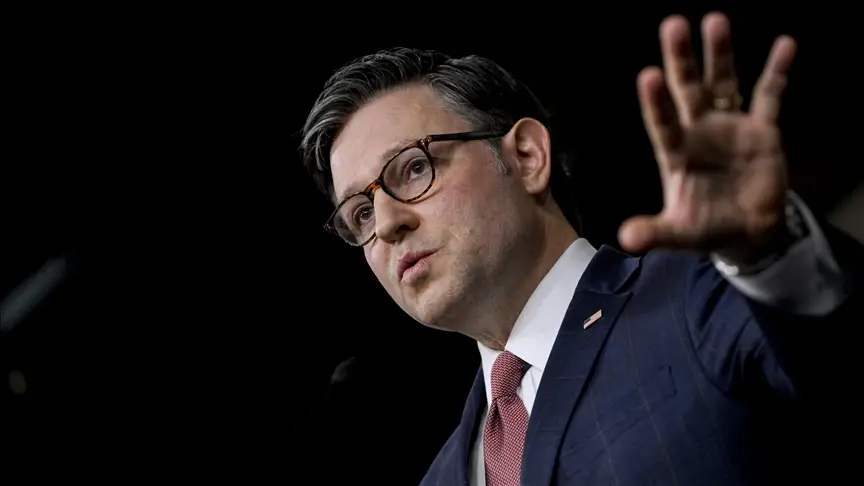There are political moments that spark debate, and then there are political moments that rip the thin surface layer off Washington and expose the steel beams underneath. What unfolded this week was the latter. The instant President Donald Trump publicly warned that a handful of Democratic lawmakers were edging into the territory of sedition—and dared to reference the legal penalties associated with it—America’s political and media class nearly combusted.
The media’s recoil was immediate, synchronized, and almost theatrical. Anchors gasped. Commentators clutched their pearls. Editorial boards rushed out statements dripping with moral outrage. One would think Trump had ordered tanks into Times Square instead of stating the painfully obvious: that members of Congress encouraging military personnel to selectively ignore lawful orders is a red line in any functioning republic.
But the outcry was never really about the seriousness of what those Democrats did. It wasn’t even about whether “sedition” was the correct word. The outrage machine was triggered because Trump spoke the quiet part out loud—and the press simply cannot allow that.
To admit that Democratic lawmakers may have crossed a constitutional boundary would disrupt the media’s favorite storyline: that Trump is always the threat, and Democrats are always the guardians of democracy. So instead of interrogating the conduct of those lawmakers, journalists pivoted reflexively to policing Trump’s tone.
It was a classic sleight-of-hand trick—one the press has perfected over two decades.
And this time, the stakes were much higher.
A Video That Said the Quiet Part Even Louder
The controversy began with a video released by a cluster of Democratic lawmakers—Sen. Elissa Slotkin, Sen. Mark Kelly, Rep. Chrissy Houlahan, Rep. Chris Deluzio, Rep. Maggie Goodlander, and Rep. Jason Crow—warning U.S. military personnel about “orders” they might receive from “this administration.”
The phrasing was deliberate. They avoided saying “President Trump,” but the implication might as well have been written in neon lights. The video suggested that troops may soon face directives that “pit our uniformed military and intelligence community professionals against American citizens.”
This was no generic civics lesson. It was a targeted political message.
The lawmakers didn’t specify which orders they believed should be defied. Instead, they sprinkled vague references to “unconstitutional directives,” “dangerous instructions,” and “unlawful actions.” Anyone familiar with the current political climate understood what they were hinting at.
What they were really talking about were Trump’s newly authorized operations targeting narco-terrorist cartels—operations that include destroying cartel boats used for drug smuggling—and the deployment of federal forces to restore order in cities where violent crime has surged under progressive leadership. These actions are legal, authorized, and within presidential power.
But these lawmakers were calling on troops to hesitate, to question, to second-guess their commander-in-chief.
And here’s where the sleight of hand becomes dangerous:
They encouraged service members themselves—not military attorneys, not commanders, not courts—to unilaterally decide what is an illegal order.
That is not how military law works.
That is not how military justice works.
And that is not how a chain of command works.
Every serious constitutional scholar, including those on the Left, understands the stakes. There is a profound difference between refusing a manifestly illegal order—and refusing an order simply because a politician told you it “sounds wrong.”
Encouraging the latter is how coups happen.
But the lawmakers delivered their warnings wrapped in patriotic language, presented as if they were protecting democracy rather than undermining it.
Trump Responds — and Washington Explodes
President Trump did not ignore the message. He rarely ignores anything this consequential.
His response was swift and blunt, posted to Truth Social in his trademark direct style. He condemned the actions of the Democratic lawmakers as “seditious behavior punishable by death,” referencing the statutory penalties attached to severe forms of sedition.
He did not call for anyone to be executed. He simply stated the law.
But in the political world of 2025, saying the word “sedition” in relation to Democrats is treated as an act of war.
Within minutes, the media erupted.
“Authoritarian warning!”
“Trump threatens death penalty!”
“President escalates against lawmakers!”
“The rhetoric of dictators!”
It was all predictable.
It was all performative.
And it completely avoided the underlying issue.
Not a single major outlet opened with the real headline:
“Democratic lawmakers urge military to consider defying the Commander-in-Chief.”
Instead, the press framed Trump’s statement as the scandal—and framed the lawmakers’ actions as civic responsibility.
Speaker Mike Johnson Refuses to Take the Bait
Reporters, eager to manufacture a Republican split, quickly chased down Speaker of the House Mike Johnson. They hoped he would reprimand Trump or distance himself from the remarks. For years, this has been the media’s favorite tactic: bait the GOP into publicly rebuking their own president.
But Johnson didn’t bite.
“What I read was he was defining the crime of sedition,” Johnson said calmly. “That is a factual statement.”
In one sentence, he defused the trap.
And then he pivoted—sharply—toward the Democrats’ conduct.
“The real issue,” he said, “is that these lawmakers released a wildly inappropriate message encouraging young troops to disobey orders.”
This hit Washington like a blast wave.
Speaker Johnson didn’t just refuse to condemn Trump—he condemned the Democrats for creating the situation in the first place.
He then went further.
“For a senator like Mark Kelly or any member of the House or Senate to behave in that kind of talk is to me so just beyond the pale,” Johnson added.
This was not a lukewarm statement.
This was not polite political language.
This was a direct accusation that these lawmakers had crossed a constitutional boundary.
Johnson ended with a decisive closing line:
“I’m not going to say anything more on it.”
Translation:
The actions speak for themselves.
The White House Turns the Spotlight Back Where It Belongs
White House Press Secretary Karoline Leavitt stepped to the podium Thursday and delivered what may go down as one of the sharpest rebukes of media bias this year. She accused the press of obsessing over Trump’s reaction while aggressively ignoring the dangerous behavior that prompted it.
“It is astonishing,” she said, “that the media is criticizing the president for responding to an open call for military members to question the lawful authority of their Commander-in-Chief.”
Then she widened the scope:
“Democrats are attempting to normalize selective obedience within the armed forces. That is not patriotism. That is not oversight. That is not democracy. That is sedition.”
Her message landed with precision.
It reframed the debate around the actual constitutional threat—not the media’s preferred narrative of “Trump anger.”
Why the Media Reacted the Way It Did
It is no mystery why journalists leapt to defend Democratic lawmakers. The media cannot afford a public conversation about the Left undermining the military chain of command—not after four years of treating any hint of defiance during the Trump presidency as a “threat to the republic.”
If a Republican had released such a video during the Biden administration, major networks would be running hour-long specials and panel shows on constitutional crisis scenarios.
But because the message came from Democrats—because the target was Trump—the media bent the rules, invented new definitions, and rewrote the narrative in real time.
It wasn’t about legality.
It wasn’t about constitutional norms.
It was about protecting the team.
This is the modern media ecosystem:
-
Democratic misconduct is always minimized.
-
Republican reactions to that misconduct are always amplified.
-
Legal definitions are reinterpreted depending on who is being accused.
-
Journalistic “neutrality” is applied unevenly and strategically.
By the time the media was finished reshaping the narrative, half the country thought Trump had issued some kind of threat—when in reality, he simply stated the penalties that have been written into U.S. law since long before he entered politics.
The Deeper Issue: Civil–Military Relations Are Not a Political Toy
Beneath the political theatrics, there is a much more serious question:
What happens to a republic when lawmakers begin urging soldiers to selectively obey orders?
The Founders feared this exact scenario.
Military obedience cannot be subject to partisan feelings.
Otherwise every administration change becomes a crisis.
America does not function if:
-
Troops obey Democrats but not Republicans.
-
“Illegal order” is redefined as “order from someone we don’t like.”
-
Service members are encouraged to substitute personal judgment for the chain of command.
That is the road to fracture, instability, and eventual collapse.
The Democrats behind the video wrap their message in constitutional language, but the principle is corrosive:
the idea that the military should have political preferences in whether to follow orders.
That is the powder keg Trump, Johnson, and Leavitt were responding to.
And it’s why their critics worked so hard to change the subject.
Where the Fight Goes From Here
This controversy is far from over. Within Congress, Republicans are quietly discussing hearings on the conduct of the lawmakers involved. Several senior GOP members believe the video crossed a line not seen since the Vietnam era.
Trump’s supporters argue that the president’s warning was not only justified—it was necessary.
Democrats, meanwhile, are attempting to shift the story onto Trump’s “dangerous rhetoric,” hoping to drown out the original scandal.
The media is doing everything it can to assist.
But Americans who watched the video, read the transcripts, and listened to the reactions saw something different:
A small group of lawmakers encouraging the military to question their Commander-in-Chief.
And a president who refused to pretend that wasn’t dangerous.
Conclusion: The Real Story Isn’t Trump — It’s Who Tried to Undermine Him
At the core, this wasn’t a fight about language.
It wasn’t a fight about Trump’s tone.
It wasn’t even a fight about sedition statutes.
It was a fight about loyalty, authority, and the stability of the American republic.
Trump spoke bluntly.
Johnson spoke precisely.
Leavitt spoke forcefully.
But the Democrats who released that video crossed a line that no amount of media spin can fully erase. They encouraged selective obedience within the United States Armed Forces.
And no matter how loudly journalists yell about Trump’s phrasing, the country now knows exactly who planted the spark.

Adrian Hawthorne is a celebrated author and dedicated archivist who finds inspiration in the hidden stories of the past. Educated at Oxford, he now works at the National Archives, where preserving history fuels his evocative writing. Balancing archival precision with creative storytelling, Adrian founded the Hawthorne Institute of Literary Arts to mentor emerging writers and honor the timeless art of narrative.
